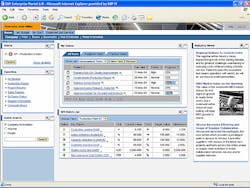Dashboards Drive Improved Performance at Dow Corning
There was no shortage of data in its production and enterprise platforms. The problem was bringing the information together in one solution. Kirk Royster, who is manager of global enterprise architecture at Dow Corning, in Midland, Mich., and reports to the chief information officer, was given the task of finding that solution.
Royster is responsible for setting the company’s road map for emerging technologies. This includes determining the internal and external value propositions for a technology, ensuring alignment of the investment strategy with the business strategies, and transitioning the technology into the business units.
Over the last three years, the Advanced Technologies and Ventures Business of Dow Corning has implemented tools from Lighthammer, a collaborative manufacturing software supplier in Exton, Pa., to provide a supply chain solution based on key performance indicators (KPIs) that include a mix of financial and production metrics. The concept was to create better business decision makers throughout the supply chain, by delivering information that was closer to real time. This improves performance in areas such as real-time capital asset utilization, product delivery, and troubleshooting of customer complaints.
One of the things the system achieved was to reduce the time to respond to customer inquiries from days to one-to-two hours, in many cases. Another benefit was increased sales, as a result of increased customer satisfaction with response times, product quality and delivery performance.
“What was missing,” says Royster, “was the ability to interact with workflows from our SAP ERP (Enterprise Resource Planning) system. We wanted something bigger than just a dashboard of KPIs. Lighthammer gave us access to all of the manufacturing production data. What we needed was for the SAP and Lighthammer solutions to work together in a common framework.”
A day in the life
In the late 1990s, Dow Corning had implemented a single instance of SAP across all of its business units, which provided the advantage of common transactional processes throughout the global enterprise. One of the next major opportunities was to eliminate the barriers between SAP and the plant floor, which Dow Corning accomplished primarily by working with SAP and its partners, such as Lighthammer. Early in 2005, Dow Corning will complete the installation of a geographically distributed framework of Lighthammer software, to serve the needs of its supply chain.
“We have a major project underway right now, with the pilot scheduled for this month, called our Supply Chain Leader Information Delivery Project,” says Royster. A supply chain leader at Dow Corning is an individual with responsibility for a specific supply chain, which maps to the individual business units. The project also includes additional related roles such as planners/schedulers and production leaders. There are 100 to 150 supply chain leaders and related roles across the company.
After an analysis of “a day in the life of the supply chain leader and related roles” using a Six Sigma methodology, Dow Corning identified more than 60 common KPIs, and prioritized 11 of them that had the greatest impact on business performance. The company chose the Plant Manager Dashboard from SAP, with enhancements from Lighthammer, as the enabling information portal.
The prioritized KPIs displayed on the dashboard are measures related to production costing, delivery performance, quality performance, operational equipment effectiveness (OEE), inventory levels and other financial metrics. “With the Plant Manager Dashboard, these KPIs and measurements are made much more available to the supply chain leaders throughout the day,” notes Royster, “but there’s a lot more to this system than that.” The KPI information is tied to target levels, with high and low limits. The new framework has the capability to send personalized alerts and notifications via e-mail if something is out of tolerance.
“But even that would not have been enough for us to justify this system. Here’s what’s coming—the concept of the universal work list,” says Royster. “If a KPI falls out of range and an action needs to be taken, then that task will be put into a workflow instruction and displayed in the portal so the appropriate leader can understand the issue, make a decision and take corrective action.” It’s the combination of the SAP and Lighthammer systems that provide the top-level KPI data, and the drill-downs to the production data for alerts and workflows.
In the pilot phase, Dow Corning will roll out the dashboards, with an initial set of KPIs, to supply chain leaders, plant managers, production planners and schedulers, customer service personnel, accountants, financial planners and inventory planners, among others. The remaining KPIs will be deployed on the dashboards after the first quarter of 2005.
One of the major benefits of the solution, says Royster, “is that accountability has become much more realistic. Individuals with objectives to improve performance, are now aware of and sensitized to that performance on a day-in and day-out basis.”

